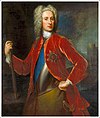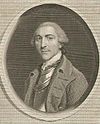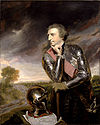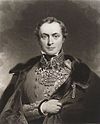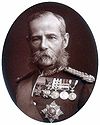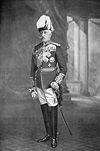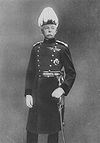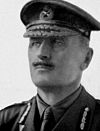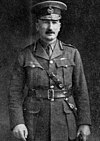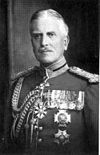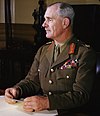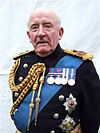Field marshal (United Kingdom)
Field Marshal has been the highest rank in the British Army since 1736. A five-star rank, it is equivalent to an Admiral of the Fleet in the Royal Navy or a Marshal of the Royal Air Force, with different insignia: two crossed batons surrounded by yellow leaf. Like the other five-star officers in their respective services, field marshals remain officers of the British Army for life, though on half-pay when not in an appointment.[1][2] The rank has been used sporadically throughout its history and was vacant through parts of the eighteenth and nineteenth centuries. After the Second World War, it became standard practice to appoint the Chief of the Imperial General Staff (later renamed Chief of the General Staff) to the rank on their last day in the post. Army officers occupying the post of Chief of the Defence Staff, the professional head of all British armed forces, were usually promoted to the rank upon their appointment.[3]
In total, 138 men have held the rank of field marshal, of which 105 were professional soldiers in the British Army and a further 11 spent their careers in the British Indian Army, while 22 men were appointed to the rank without having served in either. Of those, four British monarchs—Edward VII, George V, Edward VIII and George VI—appointed themselves to the rank on their coronations and two British consorts were appointed by their queens—Albert, Prince Consort and Prince Philip, Duke of Edinburgh by Victoria and Elizabeth II respectively. The remainder were predominantly foreign monarchs and emperors, though two distinguished foreign military officers and one foreign statesman were also granted the rank.[3]
A report commissioned by the Ministry of Defence in 1995 made a number of recommendations for financial savings in the armed forces' budget, one of which was the abolition of the five-star ranks. Part of the rationale behind the recommendation was that the ranks of field marshal, admiral of the fleet and marshal of the Royal Air Force were disproportionate to the size of the forces commanded by these officers and that none of the United Kingdom's close allies, such as the United States (which reserves the rank of General of the Army for wartime), used such ranks. The recommendation was not taken up in full, but the convention of promoting service chiefs to five-star ranks was stopped and the ranks are now reserved for special circumstances. Lord Inge was, in 1994, the last officer to be promoted to the rank. Inge relinquished the post of Chief of the Defence Staff (CDS) in 1997 and his successor, Sir Charles Guthrie, was the first officer not to be promoted upon appointment as CDS.[3]
Professional soldiers

The vast majority of officers to hold the rank of field marshal were professional soldiers in the British Army, though 11 served as officers in the British Indian Army. Between them, the 116 professional field marshals took part in over 320 engagements, covering almost every battle and campaign in which the British Army was engaged in the 250-year history of the rank. At least 57 field marshals were wounded in battle earlier in their careers, of whom 24 were wounded more than once, and eight had been prisoners of war. Fifteen future field marshals were present at the Battle of Vitoria, where the Duke of Wellington earned the rank, and 10 others served under Wellington at the Battle of Waterloo.[3]
Four field marshals—Sir Evelyn Wood, Sir George White, Earl Roberts and Lord Gort—had previously received the Victoria Cross (VC)—the United Kingdom's highest and most prestigious award for gallantry "in the face of the enemy". Wood, a famously injury-prone officer, was awarded the VC for two actions in 1858 in which he first attacked a group of rebels in India and later rescued an informant from another group of rebels. White, a cavalry officer, led two charges on enemy guns in Afghanistan in 1879, while Gort, of the Grenadier Guards, commanded a series of attacks while severely wounded during the First World War in 1918. Earl Roberts received his VC for actions during the Indian Mutiny.[4][5][6][7][8]
Wellington, 44 at the time of his promotion, was the youngest officer to earn the rank of field marshal. Charles Moore, 1st Marquess of Drogheda was the oldest, promoted at the age of 91, while a further 23 officers were promoted to field marshal in their eighties. Wellington was also the only field marshal ever to become Prime Minister of the United Kingdom, though four others became cabinet ministers.[3]
No professional officer has reached the rank of field marshal without having served in the cavalry, infantry, Royal Armoured Corps, Royal Artillery or Royal Engineers.[3] Only one, Sir William Robertson, has held every rank in the British Army, from private soldier to field marshal.[9]
Other appointments
Of the 138 officers to hold the rank of field marshal, 22 were appointed to the rank without having had a career in the British Army or British Indian Army. The majority of these men (no women have ever held the rank) were foreign monarchs and emperors, with only ceremonial connections, if any, to the British Army. However, two foreign army officers—Ferdinand Foch of France and Sir Thomas Blamey of Australia—were appointed to the rank in recognition of their contributions to the First and Second World Wars respectively.[3][15][16]
| Seniority | Name and style | Image | Born | Died | Date of appointment | Notes |
|---|---|---|---|---|---|---|
| 25 | Ernest Augustus I of Hanover | 
|
1771 | 1851 | 6 November 1813 | |
| 28 | Leopold I of Belgium | 
|
1790 | 1865 | 24 May 1816 | |
| 33 | Prince Albert of Saxe-Coburg and Gotha | 
|
1819 | 1861 | 8 February 1840 | Husband of Queen Victoria |
| 34 | William II of the Netherlands | 
|
1792 | 1847 | 28 July 1845 | |
| 54 | Edward VII of the United Kingdom | 
|
1841 | 1910 | 29 May 1875 | British Monarch, 1901–1910 |
| 71 | Wilhelm II, German Emperor | 
|
1859 | 1941 | 27 January 1901 | |
| 76 | Franz Joseph I of Austria | 
|
1830 | 1916 | 1 September 1903 | |
| 80 | George V of the United Kingdom | 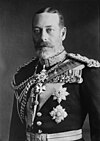
|
1865 | 1936 | 7 May 1910 | British Monarch, 1910–1936 |
| 84 | Nicholas II of Russia | 
|
1868 | 1918 | 1 January 1916 | |
| 87 | Emperor Taishō (Yoshihito) | 
|
1879 | 1926 | 1 January 1918 | Emperor of Japan |
| 88 | Ferdinand Foch | 
|
1851 | 1929 | 19 July 1919 | French Army officer and Marshal of France |
| 94 | Albert I of Belgium | 
|
1875 | 1934 | 4 July 1921 | |
| 98 | Alfonso XIII of Spain | 
|
1886 | 1941 | 3 June 1928 | |
| 99 | Hirohito | 
|
1901– | 1989 | 26 June 1928 | Emperor of Japan |
| 104 | Edward VIII of the United Kingdom | 
|
1894 | 1972 | 21 January 1936 | British Monarch, January–December 1936 |
| 106 | George VI of the United Kingdom | 
|
1895 | 1952 | 12 December 1936 | British Monarch, 1936–1952 |
| 108 | Jan Smuts | 
|
1870 | 1950 | 24 May 1941 | |
| 118 | Sir Thomas Blamey | 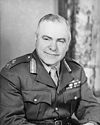
|
1884 | 1951 | 24 May 1941 | Australian Army officer |
| 119 | Prince Philip, Duke of Edinburgh | 
|
1921 | Living | 15 January 1953 | Husband of Queen Elizabeth II |
| 124 | King Mahendra of Nepal | 1921 | 1972 | 17 October 1962 | ||
| 125 | Haile Selassie I | 
|
1892 | 1975 | 20 January 1965 | Emperor of Ethiopia |
| 131 | King Birendra of Nepal | 1945 | 2001[17] | 18 November 1980 |
Notes
- ^ Titles and styles are those held by the field marshal when they died, or those currently held in the case of living field marshals. All post-nominal letters, with the exception of "VC" (denoting the Victoria Cross) are omitted.
- ^ The regiment given is the regiment into which the field marshal was commissioned. This is not necessarily the regiment the officer first joined, nor is it necessarily the regiment in which the officer spent most of his career. A "—" indicates that the officer was not initially commissioned into a formal regiment.
References
- General
- Heathcote, Tony (1999). The British Field Marshals, 1736–1997: A Biographical Dictionary. Barnsley: Pen and Sword Books. ISBN 978-0-85052-696-7.
{{cite book}}:|access-date=requires|url=(help) - Aschcroft, Michael (2007). Victoria Cross Heroes. London: Headline Publishing Group. ISBN 978-0-7553-1633-5.
{{cite book}}:|access-date=requires|url=(help)
- Specific
- ^ "Field marshal". Brewer's Dictionary of Phrase and Fable. Edinburgh: Chambers Harrap. 2009. Retrieved 12 June 2011. (subscription required)
- ^ "Telegraph style book: the Services". The Daily Telegraph. Telegraph Media Group. 12 April 2008. Retrieved 13 June 2011.
- ^ a b c d e f g Heathcote, Introduction
- ^ Ashcroft, pp.79–81.
- ^ "No. 22419". The London Gazette (invalid
|supp=(help)). 4 September 1860. - ^ "No. 24981". The London Gazette (invalid
|supp=(help)). 3 June 1881. - ^ "No. 31034". The London Gazette (invalid
|supp=(help)). 26 November 1918. - ^ "No. 22212". The London Gazette. 24 December 1858.
- ^ Lethbridge, JP. "From Private to Fiel Marshal". Britain at War Magazine. Green Arbor Publishing. Retrieved 13 June 2011.
- ^ Heathcote, Table 1, pp.320–326.
- ^ van der Vat, Dan (12 December 2001). "Obituary: Field Marshal Lord Carver". The Guardian. Guardian Media Group. Retrieved 11 June 2011.
- ^ "Obituaries: Field Marshal Sir Roland Gibbs". The Daily Telegraph. Telegraph Media Group. 2 November 2004. Retrieved 11 June 2011.
- ^ "Obituary: Field Marshal Sir John Stanier". The Times. Times Newspapers Ltd. 13 November 2007. Retrieved 11 June 2011.
- ^ "Obituary: Field Marshal Sir Nigel Bagnall". The Independent. Independent Print Limited. 11 April 2002. Retrieved 11 June 2011.
- ^ Heathcote, pp.122–125.
- ^ Heathcote, pp.47–52.
- ^ "Nepal mourns slain king". BBC News. BBC. 2 June 2001. Retrieved 11 June 2011.


